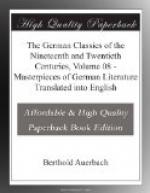Then came war and desolation, poverty and misery. Decadent men become dry and pedantic. Oppression and tyranny without engender pedagogism within. Thus the art of the Rococo became in the eighteenth century poor, sober, squeezed into rules, deprived of every passionate impulse which formerly might have reconciled us to its efflorescence. Mannerists of genius can glitter alluringly, pedantic ones are deterringly boring. The Pigtail is the dried-up Rococo, trimmed according to academic rules. The luxurious Rococo flora, composed of all kinds of plants, poisonous herbs, and weeds is presented to us, in the age of the Pigtail, as a dead herbarium on blotting-paper.
The periods of the history of art are measured only in round numbers. Thus the plastic artist may well say that the Renaissance belongs to the sixteenth and seventeenth centuries, the Baroque to the seventeenth, and the Rococo and the Pigtail to the eighteenth. But for the historian of culture, on the other hand, this calculation is a little too round. German literature during a good part of the Rococo period already belongs to the Pigtail, and it frees itself from the Pigtail in the very densest Pigtail period of the architect and the sculptor. Palestrina and Orlando di Lasso represent the aftermath of the Middle Ages in the period of the Renaissance; Haendel and Bach, in the eighteenth century, would have stood much closer to the Rococo than to the Pigtail, if they had not been such original and peculiar geniuses that one cannot quite classify them under these heads at all.
And yet the Rococo strikes a key-note which resounds through the whole history of culture of the seventeenth century, just as the Pigtail does through that of the eighteenth. On that account one need not give up the general character of the period, and yet one can see how the Rococo still presses forward in the Pigtail age. For in the battle of spirits the columns do not advance with even step and even front like the battalions on the parade ground, but here the file-leaders are often a century in advance of the centre.
When, therefore, the history of art and morals of the previous century shows us how at that time discordant spirits nevertheless wrestled with one another on common ground, the excess of fantastic arbitrariness with the most sober, universal pedantry, I call it simply a struggle of the Rococo with the Pigtail.
Men despised real history and broke with it, to be subjected all the more to the tyranny of historical ghosts. While the poets were fettered in blind worship of the unities of Aristotle as of a fundamental historical law, Houdart, without understanding a word of Greek, corrected Homer, whose poetry did not seem to conform sufficiently to rule.




